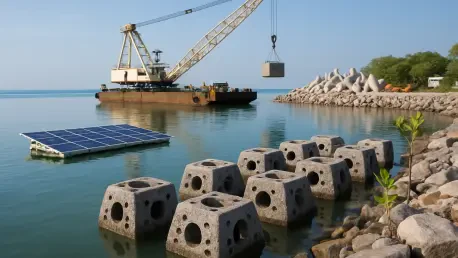What happens when one of the busiest trade gateways in the United States faces unprecedented demand while grappling with environmental challenges? At the Port of Long Beach, California, a staggering $2.2 billion project is underway to answer that question, led by Jacobs, a powerhouse in infrastructure development. This ambitious expansion promises to revolutionize cargo movement and set new standards for sustainability. This isn’t just a local upgrade—it’s a bold vision for the future of American trade, with implications that ripple far beyond the West Coast.
The significance of this endeavor cannot be overstated. As the second busiest container port in the nation, the Port of Long Beach handles a massive share of imports and exports, directly impacting the economy and supply chains. With Jacobs at the helm of the Pier B On-Dock Rail Support facility expansion, the project aims to boost capacity, slash emissions, and alleviate community concerns over air quality. This story delves into how a single port transformation could redefine logistics and environmental responsibility on a national scale.
A Critical Hub Under Pressure
The Port of Long Beach stands as a linchpin in global trade, processing millions of containers each year that stock shelves across the country. Its role as a gateway for nearly 20% of U.S. imports makes it indispensable, yet the strain of rising demand has exposed critical bottlenecks. Truck congestion clogs local roads, while emissions from idling vehicles harm surrounding neighborhoods, creating an urgent need for innovative solutions.
This isn’t merely about moving goods faster—it’s about balancing economic vitality with community well-being. The port’s challenges reflect broader issues in logistics, where efficiency often clashes with environmental goals. As supply chains grow more complex, the pressure to modernize infrastructure while cutting pollution has become a defining issue for major ports nationwide.
Jacobs Steps Up to the Challenge
At the heart of this transformation is Jacobs, tasked with overseeing the Pier B expansion, a project set to redefine cargo handling by 2032. The plan involves enlarging the rail yard from 82 to 171 acres, a massive leap that will increase on-dock rail capacity to manage up to 4.7 million 20-foot containers annually. This shift from truck to rail transport is expected to drastically reduce road traffic and improve operational flow.
Beyond sheer scale, Jacobs’ role includes managing 10 intricate construction contracts, a testament to the complexity of this multi-billion-dollar effort. Their expertise, honed through prior projects like the Fireboat Station 20 at the same port, positions them as a trusted partner. Local stakeholders see this as more than construction—it’s a commitment to solving long-standing logistical headaches with precision and foresight.
Cutting Emissions for a Cleaner Tomorrow
One of the most compelling aspects of the Pier B project is its focus on sustainability. By prioritizing rail over road transport, the initiative aims to cut greenhouse gas emissions significantly, addressing air quality concerns that have plagued nearby communities for decades. This aligns with global trends toward greener logistics, where ports are increasingly held accountable for their environmental footprint.
The impact extends beyond numbers on a spreadsheet. Cleaner air means healthier residents, while reduced truck traffic eases strain on local infrastructure. Jacobs’ involvement ensures that these environmental goals are woven into the project’s design, offering a model for how large-scale infrastructure can serve both economic and ecological priorities without compromise.
Leadership and Trust in Action
Confidence in this project’s success is bolstered by voices of authority at the Port of Long Beach. Mario Cordero, the port’s CEO, has described the expansion as an “enormous undertaking,” highlighting the critical trust placed in Jacobs to deliver results. Their proven track record, including waterfront projects at the Port of San Francisco, adds a layer of assurance that the 2032 deadline will be met with quality intact.
This trust isn’t built on promises alone. Jacobs’ broader portfolio, spanning sustainable water solutions and advanced facilities as noted in recent corporate updates, showcases their ability to tackle multifaceted challenges. For local leaders and residents, seeing a familiar partner take on this monumental task provides a sense of continuity and reliability in an era of rapid change.
Lessons for Ports Nationwide
The Pier B expansion offers a blueprint for other ports grappling with similar issues of capacity and sustainability. A key takeaway is the emphasis on rail as a primary mode of cargo transport, a strategy that minimizes road congestion and pollution. Ports facing comparable growth pressures could adapt this approach to achieve scalable, efficient operations.
Equally important is the integration of environmental goals into infrastructure planning. Designing projects with community health and global green standards in mind isn’t optional anymore—it’s essential. Partnering with experienced firms like Jacobs, capable of navigating long-term, complex initiatives, ensures that ambitious timelines are realistic and outcomes are sustainable, setting a precedent for future developments.
Looking back, the transformation of the Port of Long Beach through Jacobs’ leadership marked a turning point in how America approached trade infrastructure. The project didn’t just expand capacity; it redefined what a modern port could achieve by blending efficiency with responsibility. As other regions took note, the focus shifted to replicating this balance—prioritizing actionable strategies like rail investment and sustainability integration. The legacy of this effort became a call for ports everywhere to innovate boldly, ensuring that growth never came at the expense of the environment or the communities they served.









